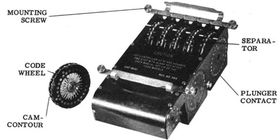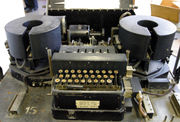
Combined Cipher Machine
Encyclopedia

Cipher
In cryptography, a cipher is an algorithm for performing encryption or decryption — a series of well-defined steps that can be followed as a procedure. An alternative, less common term is encipherment. In non-technical usage, a “cipher” is the same thing as a “code”; however, the concepts...
machine system for securing Allied communications during World War II
World War II
World War II, or the Second World War , was a global conflict lasting from 1939 to 1945, involving most of the world's nations—including all of the great powers—eventually forming two opposing military alliances: the Allies and the Axis...
and for a few years after amongst NATO. The British
United Kingdom
The United Kingdom of Great Britain and Northern IrelandIn the United Kingdom and Dependencies, other languages have been officially recognised as legitimate autochthonous languages under the European Charter for Regional or Minority Languages...
Typex
Typex
In the history of cryptography, Typex machines were British cipher machines used from 1937. It was an adaptation of the commercial German Enigma with a number of enhancements that greatly increased its security....
machine and the US
United States
The United States of America is a federal constitutional republic comprising fifty states and a federal district...
ECM Mark II were both modified so that they were interoperable.

The adapter to convert the ECM into the CCM was denoted the ASAM 5 by the US Army (in 1949) and CSP 1600 by the US Navy (the Navy referred to the entire ECM machine with CCM adapter as the CSP 1700). The adapter was a replacement rotor basket, so the ECM could be easily converted for CCM use in the field. A specially converted ECM, termed the CCM Mark II, was also made available to Britain and Canada.

SIGROD was an implementation of the CCM which, at one point, was proposed as a replacement for the ECM Mark II (Savard and Pekelney, 1999).
Typex 23 was a later model of Typex adapted for use with the Combined Cipher Machine.
Security
While Allied codebreakers had much success reading the equivalent German machine, the Enigma, their German counterparts, although performing some initial analysis, had no success with the CCM.However, there were security problems with the CCM. In one case, it was discovered that certain rotor combinations produced a dangerously short period of 338, and that the rotor wiring could have been recovered from an actual 1,000-group message that had been sent using the machine.
In 1952, a later version of CCM, "Ajax", was also found to have security problems.

